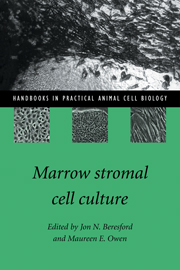Book contents
- Frontmatter
- Contents
- List of contributors
- Preface to the series
- Preface
- 1 The marrow stromal cell system
- 2 The bone marrow stroma in vivo: ontogeny, structure, cellular composition and changes in disease
- 3 Isolation, purification and in vitro manipulation of human bone marrow stromal precursor cells
- 4 Isolation and culture of human bone-derived cells
- 5 Marrow stromal adipocytes
- 6 Osteoblast lineage in experimental animals
- 7 Chondrocyte culture
- 8 Osteogenic potential of vascular pericytes
- Index
5 - Marrow stromal adipocytes
Published online by Cambridge University Press: 20 January 2010
- Frontmatter
- Contents
- List of contributors
- Preface to the series
- Preface
- 1 The marrow stromal cell system
- 2 The bone marrow stroma in vivo: ontogeny, structure, cellular composition and changes in disease
- 3 Isolation, purification and in vitro manipulation of human bone marrow stromal precursor cells
- 4 Isolation and culture of human bone-derived cells
- 5 Marrow stromal adipocytes
- 6 Osteoblast lineage in experimental animals
- 7 Chondrocyte culture
- 8 Osteogenic potential of vascular pericytes
- Index
Summary
Introduction
Development
The presence of adipocytes in marrow can be traced back phylogenetically to those species where the bone marrow first appears as a haematopoietic organ. In mammals, the extent of bone marrow adipogenesis is age related. In the neonate, the marrow cavity is filled predominantly with ‘red’ haematopoietic marrow and adipocytes are rarely seen. Soon after birth, adipocytes can be found in the periphery of the axial skeleton; for example, in the distal digits and tail vertebrae. With advancing age, there is a gradual replacement of the haematopoietic marrow with ‘yellow’ fatty marrow, a process which accelerates after puberty. The extent of development of fatty marrow correlates with the overall size and surface area : volume ratio of the animal. Thus, in the relatively small adult mouse, fatty marrow is limited to the distal tibia and fibula and the tail vertebrae, whereas in man it is present in up to 50% of the skeleton. The bulk is found in the long bones of the appendicular skeleton and, by the third decade of life, ≥90% of the femoral marrow cavity is occupied by fat. The development with age of marrow adipose tissue results from an increase in both the number and size of adipocytes (see also Bianco & Riminucci, Chapter 2).
Changes in the volume of marrow adipose tissue have also been correlated with the development of temperature gradients within the body.
- Type
- Chapter
- Information
- Marrow Stromal Cell Culture , pp. 67 - 87Publisher: Cambridge University PressPrint publication year: 1998
- 10
- Cited by



